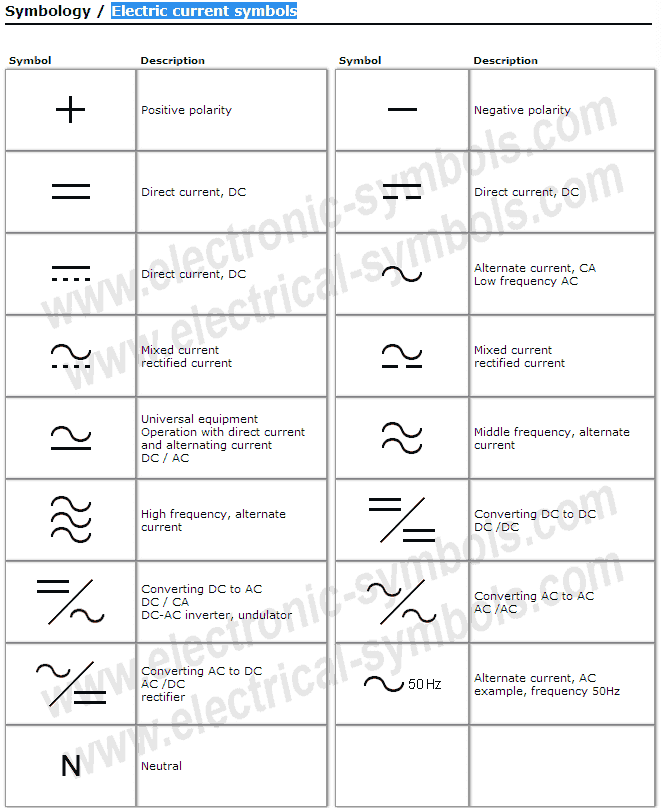AC Symbol Secrets: Decoding the Squiggle on Your Circuit
Ever stared at a circuit diagram and felt a little lost? Like you're looking at an alien language? Don't worry, we've all been there. One of the most common symbols you'll encounter is the one for alternating current (AC), that squiggly line that looks like a tiny wave. But what does it *really* mean? More than just a squiggle, this symbol represents a fundamental concept in how we power our world. This article will decode the secrets of the AC symbol, diving into its history, significance, and practical applications. Get ready to become fluent in the language of electricity!
The AC symbol, a sinusoidal wave, isn't just a random doodle. It's a visual shorthand for a complex electrical process. Alternating current, unlike its direct current (DC) counterpart, constantly reverses direction. This back-and-forth flow is represented visually by the alternating peaks and troughs of the wave symbol. Understanding this basic principle is key to grasping the function of everything from your wall socket to the power grid. So, next time you see that squiggle, remember: it's not just a line, it's a dynamic dance of electrons.
The adoption of the AC symbol wasn't arbitrary. It mirrors the actual waveform of alternating current. This visual representation makes it easy to distinguish AC from DC, which is typically represented by a straight line or a dashed line. This clear visual distinction is crucial in electrical diagrams, where clarity and accuracy can prevent potentially dangerous misinterpretations. Imagine the chaos if there wasn't a universally recognized symbol for AC! Sparks might fly, literally.
But why is AC so prevalent in our electrical systems? Why not just stick with DC? Well, AC has a significant advantage: it can be easily transformed to higher or lower voltages. This is crucial for efficient long-distance power transmission. High voltages minimize power loss during transmission, and then transformers step the voltage down to safer levels for household use. The AC symbol, therefore, represents not only the current itself but also the vast infrastructure that makes modern power distribution possible.
Historically, the standardization of electrical symbols, including the AC symbol, was a major step forward for the electrical engineering field. It allowed for clear communication and collaboration across different regions and languages. This standardization, driven by organizations like the IEEE (Institute of Electrical and Electronics Engineers), minimized confusion and promoted the safe and efficient development of electrical technologies. Imagine trying to build a complex electrical system without a common language of symbols – a recipe for disaster.
The alternating current symbol signifies a sinusoidal waveform. A simple example is the electricity delivered to your home, which typically has a frequency of 50Hz or 60Hz, meaning the current changes direction 50 or 60 times per second.
Benefits of using a standardized symbol include clear communication, reduced errors in circuit design, and enhanced safety for those working with electrical systems.
Advantages and Disadvantages of AC Power
| Advantages | Disadvantages |
|---|---|
| Efficient long-distance transmission | More complex safety considerations |
| Easy voltage transformation | Skin effect at high frequencies |
| Simpler motor construction compared to DC motors | Reactive power considerations |
Best Practices for working with AC circuits include proper grounding, using appropriate safety equipment, and understanding the specific voltage and frequency of the system.
Real-world examples of AC applications include powering homes, businesses, and industrial machinery.
Challenges in working with AC power can include dealing with reactive power, mitigating electrical noise, and ensuring proper insulation.
FAQ: What does the AC symbol look like? What is the difference between AC and DC? What is the frequency of AC power in my home? Why is AC used for power transmission? What is a transformer? How is AC voltage transformed? What are the safety precautions when working with AC power? What are the common applications of AC power?
Tips for working with AC systems include double-checking connections, using a multimeter to verify voltage and current, and always de-energizing circuits before working on them.
In conclusion, the humble AC symbol, that seemingly simple squiggle, represents a foundational concept in electrical engineering. It's a visual shorthand for the dynamic flow of alternating current, the backbone of our modern power grid. Understanding this symbol and what it represents is crucial for anyone working with or even just curious about electricity. From powering our homes to driving industrial machinery, AC plays a vital role in our daily lives. The benefits of standardized symbols like the AC symbol are undeniable: clear communication, reduced errors, and enhanced safety. So, the next time you see that squiggly line, take a moment to appreciate the complex system it represents and the power it holds. By learning the language of electricity, we empower ourselves to understand and interact with the technological world around us more effectively and safely. Explore the resources available online and in libraries to deepen your understanding of AC power and its applications. The more you learn, the more you'll appreciate the ingenuity and impact of this fundamental electrical concept.
Unlocking german tv whats das im ndr fernsehen all about
The iconic 90s fashion a blast from the past
Transform your sanctuary exploring popular master bedroom wall colors














